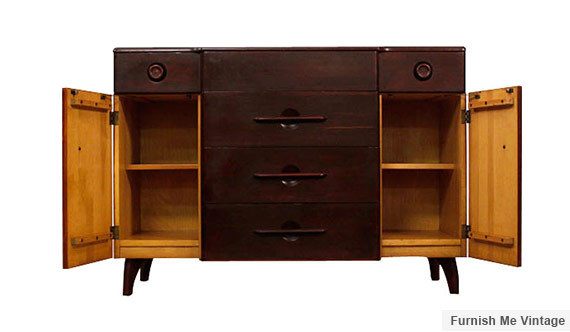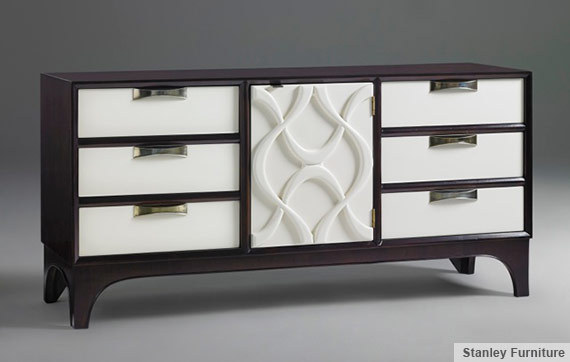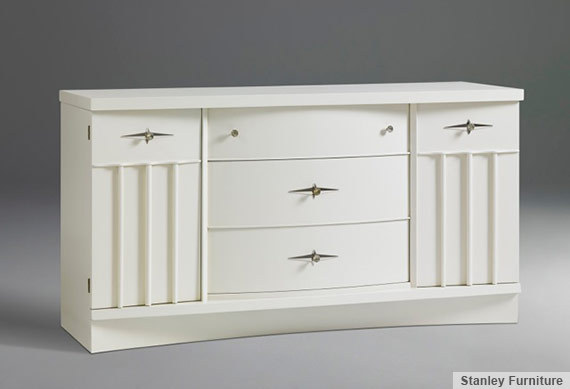In the world of retro decorating, no topic seems to generate as much controversy as whether it's OK — or outright heresy — to paint original-finish wood furniture. For example, in this story pondering the fate of a beat-up Heywood Wakefield table, the offense and defense were lined up and ready with very strong opinions indeed.
While I'll stop short of saying it's a decorating mortal sin to paint wood furniture, I do think it's a decision to take slowly. Wading through many often-heated discussions of this issue on my blog, I came up with three key reasons to skip the paint ... and on the flip side, two that suggest: Upcycle away!
1. The furniture has value that will endure and grow
Sometimes I point at the laugh lines and crows' feet slowly multiplying on my face and proclaim to my friends, "Those aren't wrinkles, they're patina — and everyone knows original patina is worth the big bucks!"
Yes, the expert appraisers on Antiques Roadshow have taught us: Mess with the original finish on old wood furniture at your own financial peril.
I also asked renowned furniture designer Vladimir Kagan: To paint, or not to paint? I was not one whit surprised at his quick and decisive response:
"I am dead against painting any furniture that was created to be seen in wood," Kagan said. "Wood grain and color is beautiful, it is an art to construct good wood furniture and good joinery. Painting the wood is done to camouflage bad workmanship."
And — a bonus story from Kagan's fascinating life history! He added:
"Having said that, historically some excellent furniture was painted to prevent it from being stolen or confiscated as prizes of war. I own one such cabinet that my father found back in the thirties and realized by its construction that it concealed a treasure. And sure enough, after stripping five coats of different colors of paint, he revealed a masterpiece of inlaid veneers and fine oak construction. An 18th Century armoire."
To be sure, before you proceed to painting vintage furniture, do your homework to determine its underlying value. A quick place to start researching is within ebay's archive of sold listings. The more precious the piece, the less you should mess with it. Not only would painting erase its value, but yes, put me the camp that believes it would be heartbreaking to destroy the aged authenticity of a truly rare piece of furniture.
The verdict: DO NOT paint.
2. The piece is made of high-quality wood
Of course, most pieces of vintage furniture are not immensely valuable - and here's where black and white distinctions begin to fade to gray. That said, I think there are very strong reasons to stick with the original wood finish.
First, even lesser-treasures have underlying value that may increase — but only if the wood finish is left in place. There are and always will be aficionados who will pay a premium for un-remuddled antiques.
Second, vintage furniture was often made with old growth hardwoods, now long gone. Ever lifted that stuff? It's heavy! And of course, the wood itself can be really gorgeous. The beauty of any given piece of furniture comes from not only its design lines, but also from its materials. Let the designer's original intention — glowing wood grain — shine through!
Jackie Williams, co-owner of the midcentury modern design mecca Furnish Me Vintage in St. Petersburg, Florida, agrees. "Most American furniture from this era was manufactured. Even so, the design and manufacturing was all about quality, craftsmanship and materials. If a piece of wood furniture can be appreciated in its current condition, or if it can be restored to its original wood finish, don't paint it."
The Verdict: DO NOT paint.
3. You have the right tools to do the job
We all love hands-on projects that make our home our own. But stripping and repainting furniture not only does irreversible damage to the original factory finish, it is a messy task that — done well — requires the proper equipment, safety and environmental processes, materials, and patience.
To showcase their design heritage, Stanley Furniture recently scoured the U.S. for 60+ pieces of their vintage midcentury furniture. Then, they completely rebuilt and refinished each one. In some cases, the furniture was re-stained just as it had been in the 1960s. But Stanley also painted a number of pieces for a more retro-contemporary "today" look.
Horrors!? No. I was absolutely okay with it. These pieces were meticulously restored by Stanley craftspeople in their studios — much like vintage Ferraris are meticulously restored at the factory back in Italy. Reflecting the quality of craftsmanship, the Stanley pieces were sold — in a snap — for thousands of dollar each.
The Verdict: Paint the piece.
4. You're really, really, REALLY into Pinterest trends
Yes, trends in furniture finishes come — and then they go. Take care with the DIY mania or beware, it may look like Pinterest threw up in your living room.
"There is some epidemic of painting beautiful furniture going around," a reader recently agreed. "In a few years, when the color or fad is finally over, what a job ahead... But never will that beauty be restored."
If you are a practical, thrifty sort, who wants a furniture finish that's about as timeless as you can get, I suggest: A warm, medium-toned hardwood. It may not be hugely "in" at any given time — but it will never be hugely "out" either. (This same logic goes for kitchen cabinets.) An ombre-painted dresser, on the other hand, will scream "2014!" now and forever after. Don't get me started on ombre dressers.
The Verdict: DO NOT paint.
5. You saved the piece from a landfill

"Sadly, someone had already 'refinished' this Young Stuart credenza in a dark, poorly applied stain," said Jackie Williams of Furnish Me Vintage. "Removing the dark, messy stain to restore the original finish would be a daunting task. Since there is no real collector's market and the piece is already is poor condition, you're not doing any damage by painting. In fact, you're giving it a new lease on life."
So the furniture is a wreck — the original finish is shot and the wood is meh? Jackie Williams agreed, "If it's too far gone to restore and you're saving it from a landfill, go ahead and paint it — you're enhancing its value and bringing it back into the market."
Or... you still really want the look of a painted piece even though the original finish is okay? I told my husband about this "controversy." He scrunched his eyes at me, disbelieving. "First world problem," he pointed out. Correctly.
Even many of my (often) die-hard preservationist readers could embrace the fundamental righteousness of tolerance: "I love the idea of saving old things, but by the same token — we don't live in museums (or at least we shouldn't)," said one.
Another had this great idea: "I have picked up many pieces of furniture over the years, many on the curb and in poor condition. For some time, I tortured myself over 'desecrating' the pieces with paint. But finally, I came to realize ... the value is in the rescue. I learned the hard way moving from paint brush to spray paint and, apparently, will now be investing in a sprayer. Most of the pieces get donated to a local group which provides furnishings for people moving from shelters into housing. Enjoyment for all!"
And: "Follow your heart. Get creative. Go with your vision. It's a piece of furniture. Yes, original vintage is beautiful. But so are up-cycled pieces."
The Verdict: Paint it.
For more ideas and inspiration for collecting and living with your vintage furniture, check out these posts:

